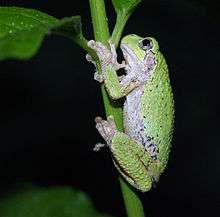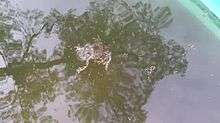Gray tree frog
| Gray tree frog | |
|---|---|
 | |
| Scientific classification | |
| Kingdom: | Animalia |
| Phylum: | Chordata |
| Class: | Amphibia |
| Order: | Anura |
| Family: | Hylidae |
| Genus: | Hyla |
| Species: | H. versicolor |
| Binomial name | |
| Hyla versicolor LeConte, 1825 | |
The gray tree frog (Hyla versicolor) is a species of small arboreal frog native to much of the eastern United States and southeastern Canada.[2]
It is sometimes referred to as the eastern gray tree frog, common gray tree frog, or tetraploid gray tree frog to distinguish it from its more southern, genetically disparate relative, the Cope's gray tree frog (Hyla chrysoscelis). It may sometimes be referred to as the North American tree frog by Europeans to distinguish it from their European tree frog (Hyla arborea).
Description
As the scientific name implies, gray tree frogs are variable in color owing to their ability to camouflage themselves from gray to green, depending on the substrate where they are sitting. The degree of mottling varies.[3] They can change from nearly black to nearly white. They change color at a slower rate than a chameleon. Dead gray tree frogs and ones in unnatural surroundings are predominantly gray. The female does not croak and has a white throat; however, the male does croak and has a black/gray throat. The female is usually larger than the male.
They are relatively small compared to other North American frog species, typically attaining no more than 1.5 to 2 in (3.8 to 5.1 cm). has a lumpy texture to it, giving them a warty appearance. They are virtually indistinguishable from the Cope's gray tree frog, H. chrysoscelis, the only readily noticeable difference being that Cope's gray tree frog has a shorter, faster call.[4] The gray tree frog also has 48 chromosomes (4n), and is called tetraploid gray tree frog in scientific circles. The Cope's gray tree frog, or diploid gray tree frog, retained its 2n (24) original chromosome count. Hybridization between these species results in early mortality of many larvae, but some individuals survive to adulthood though they have reduced fertility.[5]
Both H. chrysoscelis and H. versicolor have bright-yellow patches on their hind legs, which distinguishes them from other tree frogs, such as H. avivoca.[6] The bright patches are normally only visible while the frog is jumping. Both species of gray tree frogs are slightly sexually dimorphic. Males have black or gray throats, while the throats of the females are lighter.[7]
Tadpoles have rounded bodies (as opposed to the more elongated bodies of stream species) with high, wide tails that can be colored red if predators are in the system. Metamorphosis can occur as quickly as two months with optimal conditions. At metamorphosis, the new froglets will almost always turn green for a day or two before changing to the more common gray. Young frogs will also sometimes maintain a light green color and turn gray or darker green after reaching adulthood.
Distribution and habitat

Gray tree frogs inhabit a wide range, and can be found in most of the eastern half of the United States, as far west as central Texas and Oklahoma. They also range into Canada in the provinces of Quebec,[8] Ontario, and Manitoba, with an isolated population in New Brunswick.
The gray tree frog is capable of surviving freezing of their internal body fluids to temperatures as low as -8 °C.[9]
The gray tree frog is most common in forested areas, as it is highly arboreal. Their calls are often heard in rural residential areas of the East Coast and the Midwest. They prefer to breed in semipermanent woodland ponds without fish, but also lay eggs in swamps, vernal pools, man- made fountains and water gardens, and even in rainwater filled swimming pool covers.
Behavior
These frogs rarely ever descend from high treetops except for breeding. They are strictly nocturnal. Male gray tree frogs rarely have large choruses, as they are mostly solitary animals, but might vocalize competitively at the height of breeding periods. Gray tree frogs may congregate around windows and porch lights to eat insects that are attracted to the light. During the day they often rest on horizontal tree branches or leaves out in the open, even in the sun. Evidently they are less prone to overheating and desiccation than other amphibians and rely on their superb camouflage to hide them from predators. In captivity, they become tame and learn to associate their owners with food, even to the point of lunging at empty fingers that usually contain an insect.
Breeding

Mating calls and chorusing are most frequent at night, but individuals often call during daytime in response to thunder or other loud noises.
In captivity
References
- ↑ IUCN SSC Amphibian Specialist Group (2014). "Hyla versicolor". IUCN Red List of Threatened Species. Version 2014.3. International Union for Conservation of Nature. Retrieved 2015-01-17.
- ↑ NatureServe 'Hyla versicolor'
- ↑ Mary Hoff (March–April 2014). "Chirp, Croak, Snore". DNR (Minnesota Conservation Volunteer): 32.
- ↑ Carl Gerhardt and John A. Doherty (1988). "Acoustic communication in the gray treefrog, 'Hyla versicolor': evolutionary and neurobiological implications". J. Comp. Physiol. A 162 (2): 261–278. doi:10.1007/BF00606090.
- ↑ H. Carl Gerhardt, Margaret B. Ptacek, Louise Barnett and Kenneth G. Torke (1994). "Hybridization in the Diploid-Tetraploid Treefrogs Hyla chrysoscelis and Hyla versicolor". Copeia 1994 (1): 51–59. doi:10.2307/1446670.
- ↑ Bernard S. Martof et al. (1980). "Amphibians and Reptiles of the Carolinas and Virginia". Chapel Hill: University of North Carolina Press. ISBN 0-8078-4252-4.
- ↑ Thomas F. Tyning (1990). A Guide to Amphibians and Reptiles. Boston: Little, Brown and Company. ISBN 0-316-81719-8.
- ↑ Quebec range map, Quebec Biodiversity website
- ↑ Adaptations of Frogs to Survive Freezing
- Herps of Texas: Gray Treefrog
- Animal Diversity Web: Hyla versicolor
- Pnas.org
- Amphibiaweb.org
- Mindspring.com
External links
| Wikimedia Commons has media related to Hyla versicolor. |
| Wikispecies has information related to: Hyla versicolor |
- Gray Treefrog - Hyla versicolor Species account from the Iowa Reptile and Amphibian Field Guide
- Gray Treefrog - Hyla versicolor - audio recording of call
- Hyla versicolor LeConte, 1825 at the Encyclopedia of Life
- Tetraploid Gray Treefrog (Hyla versicolor), Natural Resources Canada
- Northern gray tree frog New Jersey Pinelands flora,fauna,and landscapes photo galleries link to northern gray tree frog photograph
